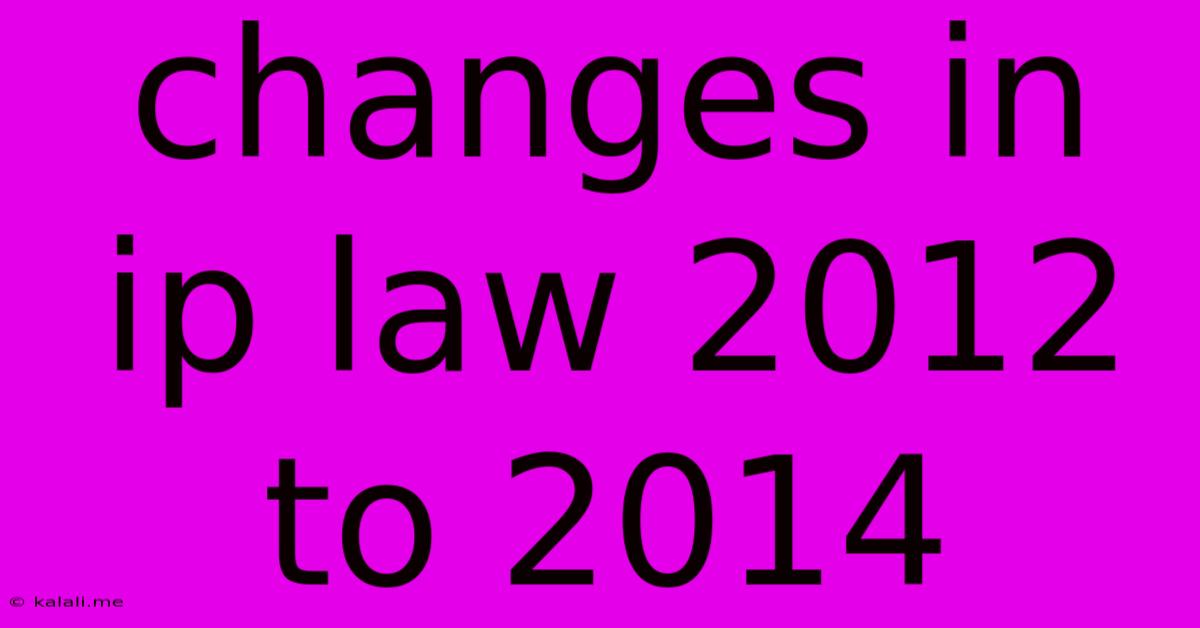Changes In Ip Law 2012 To 2014
Kalali
Jun 10, 2025 · 3 min read

Table of Contents
Significant Changes in Intellectual Property Law: 2012-2014
The period between 2012 and 2014 witnessed several key shifts in intellectual property (IP) law globally, impacting patents, trademarks, copyrights, and trade secrets. While specific changes varied by jurisdiction, certain overarching trends emerged, shaping the IP landscape for businesses and creators alike. This article will explore some of the most significant alterations during this timeframe. Understanding these changes is crucial for anyone involved in protecting or utilizing intellectual property.
Patents: Heightened Scrutiny and Enhanced Protections
One significant trend was the increased scrutiny of patent applications, particularly in the United States. The America Invents Act (AIA), enacted in 2011 but significantly impacting the landscape in 2012-2014, shifted the US patent system from a "first-to-invent" to a "first-to-file" system. This change incentivized quicker filing and increased competition. The AIA also introduced post-grant review mechanisms, allowing challenges to already granted patents, thus adding a layer of complexity and uncertainty. Simultaneously, there was a growing emphasis on the inventiveness and non-obviousness of inventions, leading to stricter examination standards for patent approval.
- Increased Examination Stringency: Patent offices worldwide showed a greater emphasis on novelty and inventive step requirements.
- First-Inventor-to-File System: The shift in the US system significantly impacted patent strategies globally.
- Post-Grant Review Mechanisms: Introduced new avenues to challenge the validity of issued patents.
Trademarks: Harmonization and Enforcement
The period 2012-2014 saw a push towards greater harmonization of trademark laws internationally. This involved efforts to streamline registration processes and enhance cooperation between national and regional IP offices. There was also a heightened focus on trademark enforcement, with increased efforts to combat counterfeiting and infringement, particularly online. This involved greater collaboration between governments and private sector organizations.
- Increased Cross-Border Cooperation: International organizations played a larger role in coordinating trademark enforcement.
- Anti-Counterfeiting Measures: Governments implemented stricter measures to combat the rise of counterfeit goods.
- Online Trademark Enforcement: Focus shifted towards combating infringement in digital spaces.
Copyright: Digital Rights Management and Technological Advancements
The rapid advancement of technology during this period presented significant challenges and opportunities for copyright law. The proliferation of digital media and online platforms brought issues relating to digital rights management (DRM) to the forefront. Discussions centered on balancing the rights of copyright holders with the accessibility of copyrighted works in the digital realm. The debate on fair use and exceptions also gained traction, particularly regarding user-generated content and transformative works.
- Digital Rights Management (DRM) Challenges: Balancing copyright protection with ease of access in the digital sphere remained a core issue.
- Fair Use/Fair Dealing Debates: Interpretation and application of fair use/fair dealing exceptions evolved significantly in response to the digital landscape.
- Emerging Technologies: The impact of new technologies like 3D printing on copyright protection was increasingly considered.
Trade Secrets: Enhanced Protection and Data Security Concerns
The increasing importance of data and confidential business information led to a renewed focus on trade secret protection. Concerns about data breaches and cyber security prompted a greater emphasis on preventative measures and stronger legal frameworks for safeguarding trade secrets. The economic espionage threat further drove the need for robust protection strategies.
- Cybersecurity and Data Protection: Growing concerns about data breaches and hacking influenced trade secret protection strategies.
- Economic Espionage: The threat of industrial espionage highlighted the importance of robust trade secret protection.
- Enhanced Confidentiality Measures: Businesses implemented more rigorous procedures to protect sensitive information.
In conclusion, the years 2012-2014 marked a period of significant transition in intellectual property law. The rise of digital technologies, increased global trade, and a heightened awareness of IP's economic value spurred changes that continue to shape how we protect and utilize creative works and inventions today. Understanding these shifts is vital for individuals and organizations navigating the complex landscape of intellectual property.
Latest Posts
Latest Posts
-
Can You Cycle In A Jersey
Jun 10, 2025
-
How Fast Do Mulberry Trees Grow
Jun 10, 2025
-
Do Recruiters Check Past Resumes For A Changed Grad Date
Jun 10, 2025
-
How To Identify Long Running Queries Java
Jun 10, 2025
-
Can You Change From Synthetic Oil Back To Regular Oil
Jun 10, 2025
Related Post
Thank you for visiting our website which covers about Changes In Ip Law 2012 To 2014 . We hope the information provided has been useful to you. Feel free to contact us if you have any questions or need further assistance. See you next time and don't miss to bookmark.